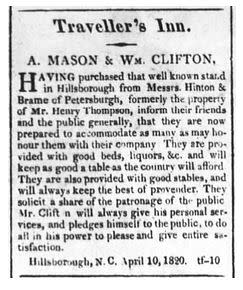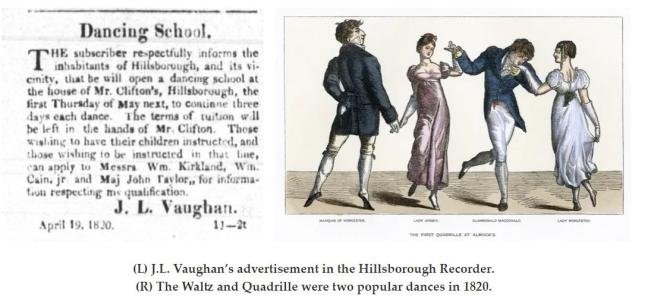Courtesy of the Orange County Historical Museum's What Happened series
Ordinaries were among the first businesses to appear in towns across America. An ordinary was an establishment that was licensed to provide the public with alcohol, food, and overnight accommodations. Beginning in 1710, North Carolina laws required ordinaries to have a yearly license. The term “ordinary” was derived from the Ordinance Bonds that required the licenses and set the prices charged for services. In Orange County Court minutes, the terms “ordinary” and “tavern” were used synonymously, although taverns tended to focus on alcohol sales while ordinaries emphasized accommodations.
From its earliest days, downtown Hillsborough had at least two ordinaries and taverns operating simultaneously – more likely three and possibly four. They serviced a community with a population of around forty along with the various visitors who attended to business in town or simply passed through. By 1800, when the population of the town had increased to 474, ordinaries were known as “inns” and they also served as apartment buildings, offering long-term rentals, primarily to unmarried men and women with no family in the area. One of the earliest and most prominent of these establishments was located on the southwest corner of Churton Street and Margaret Lane.
The first ordinary on that lot was owned by tavernkeeper Thomas Canby in the 1760s. Little is known about his business but popular forms of public entertainment in Hillsborough at that time included “drinking, gambling, cock fighting, man fighting, and gouging,” especially at the quarterly County Courts. In 1792, Henry Thompson Sr. purchased the property. When he sold it to his son eight years later, it was listed as consisting of a tavern, storehouse and dwelling house, together with kitchens stables, and outhouses. At some point during Henry Thompson Jr.’s ownership, the tavern became known as Traveller's Inn. In 1820, an advertisement for the inn boasted that it provided “good beds, liquors, &c. and will keep as good a table as the country will afford.” It also proclaimed that the inn had excellent stables and would provide the horses with the “best provender.”

By November 1822, the hotel had been sold to stockholders. William Kirkland was president of the board. Under this new management, the name of the business changed to the Union Hotel. Although the hotel remained in business under that name for at least the next thirty years, ownership continued to change. In 1845, one of the hotel’s guests, John Smith of Caswell, died in his bed. The cause of death was determined to be “intemperance.” Perhaps the name “John Smith” was an alias.

During its active years, the inn on the corner of Churton and Margaret had several long-term renters who maintained businesses in their residences. In 1820, J.L. Vaughan advertised that he was opening a dancing school for children and adults at the hotel. Ann Johnson advertised in 1839 that she worked from her home as a mantua-maker. (Mantua-makers were dressmakers). Two dentists operated businesses in the hotel: Dr. Bason in 1851 and D. Robertson in 1855. Whether Bason had a medical or other degree that merited his use of the title “doctor” is unknown. But, most likely, the appellation was assumed after an apprenticeship. Additionally, in 1854, J.H. Fritz advertised his business at the hotel as a professional teacher of Penmanship and Bookkeeping Science. He avowed that he would teach his classes scientifically and offered a money-back guarantee. Ladies would “acquire a fashionable epistolary style,” while gentlemen would learn a “legible, elegant, and rapid business hand.”

When historian and illustrator Benson Lossing visited Hillsborough in 1848, he lodged at the Union Hotel. He sketched the building across the street known as Cornwallis’ Office while sitting on the hotel’s piazza.

The date that the hotel closed is unknown as is the fate of the building. The structure was still in place in 1857 when it was mentioned in an advertisement for an equity sale across the street. However, no mention was made of a hotel being on the property in 1862 when the lot sold. In addition, the Sanborn map from 1888 only depicts a “Negro Dwelling” on the northwest corner of the lot, presumably the home of Robert Yarborough which was pictured in postcards from around 1900.
(Source: images and copy https://www.churtonstreet.org/lot-7)

